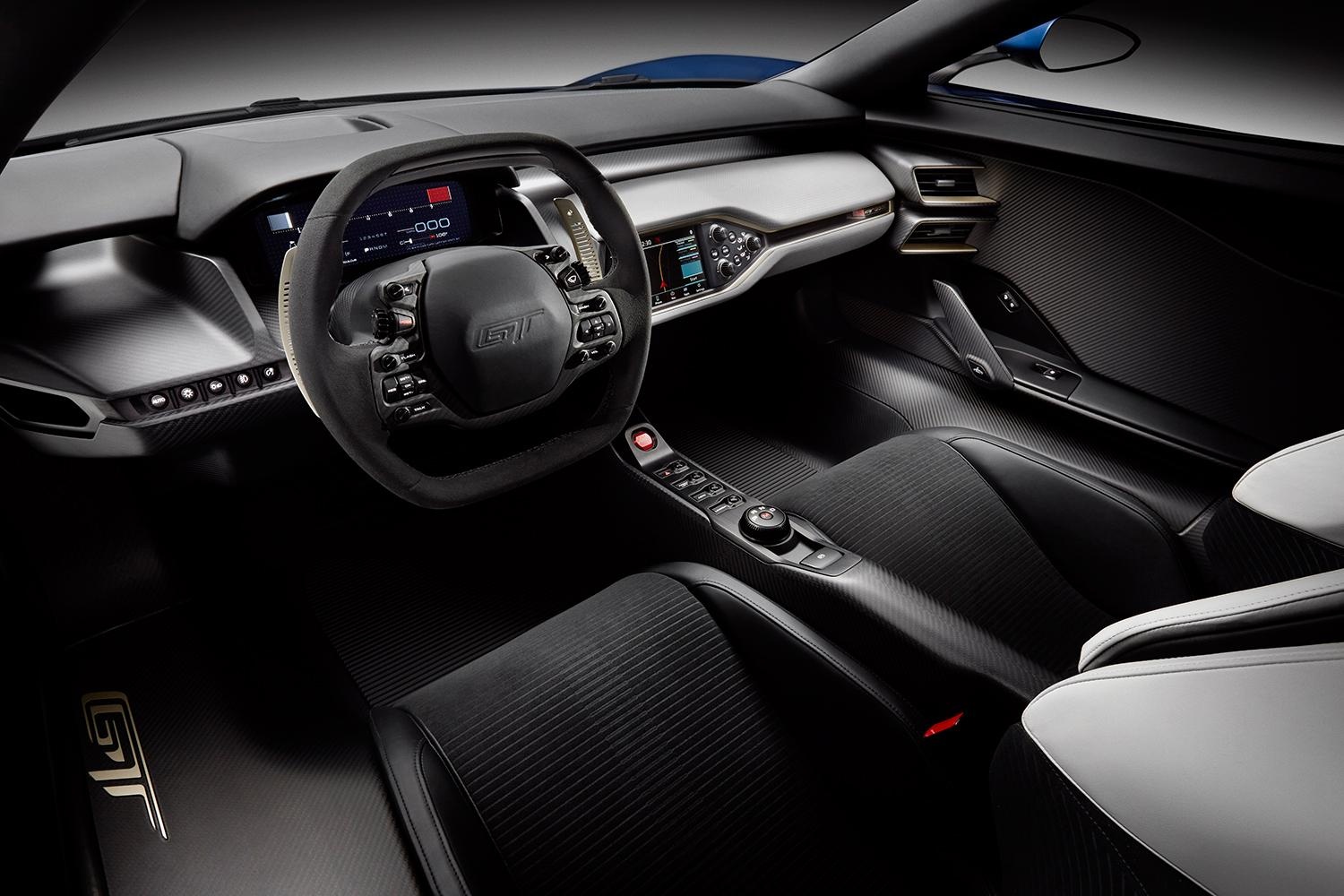
New for 2017
The Ford GT is an all-new model.
Return of a legend
In 1966, the Ford GT40 finished 1-2-3 at the 24 Hours of Le Mans, beating Ferrari in one of the most legendary victories in racing lore. In 2005, Ford paid tribute to the GT40 with its first GT road car, a retro supercar that mimicked the styling of the racer. Over a decade later, there’s a new GT and this time Ford is looking forward rather than backward.
Performance
The GT is both an homage to the original Ford GT40 that won Le Mans four times in the 1960s, and a 21st century technological flagship. It was designed in tandem with the GT racecar that won the GTE class at 2016 24 Hours of Le Mans, and applies cutting-edge tech to the pursuit of going fast.
To make the GT the best supercar it could, Ford made some unexpected decisions. While the GT40 and the last GT road car used big V8s, the new GT uses a 3.5-liter twin-turbocharged EcoBoost® V6. This engine has a racing pedigree of its own; it’s based on the engines that powered Ford IMSA Daytona Prototypes to victories at the 24 Hours of Daytona and 12 Hours of Sebring. It’s expected to make more than 600 horsepower in production guise.
 The engine is mounted in the middle of a lightweight chassis that makes extensive use of aluminum and carbon fiber. The main structure is composed of a carbon-fiber passenger cell, while aluminum front and rear subframes carry the engine, transmission, and suspension. Ford was so fanatical about weight reduction that it even used Gorilla Glass in place of conventional automotive glass in some places. The carmaker won’t say how much the GT actually weighs, but it promises one of the best power-to-weight ratios of any production car.
The engine is mounted in the middle of a lightweight chassis that makes extensive use of aluminum and carbon fiber. The main structure is composed of a carbon-fiber passenger cell, while aluminum front and rear subframes carry the engine, transmission, and suspension. Ford was so fanatical about weight reduction that it even used Gorilla Glass in place of conventional automotive glass in some places. The carmaker won’t say how much the GT actually weighs, but it promises one of the best power-to-weight ratios of any production car.
While the aerodynamic aids aren’t as aggressive as those on the GT racecar, the road car still has plenty of trick aero features. The shape of the body is meant to mimic an aircraft’s fuselage, and the GT also has an active rear spoiler that adjusts its height and angle depending on speed and driver input.
Features
The 2017 Ford GT is a two-seat supercar. Ford hasn’t released specific pricing, but says the car will start in the “mid-$400,000s.” You also can’t just walk into a dealership and buy one: Ford requires prospective buyers apply for the privilege. Production is limited to 250 units per year.
The GT emphasizes performance above all else, but it does include some convenience features. Standard equipment includes a driver-configurable 10.1-inch LCD instrument cluster, 6.5-inch central touchscreen with pinch-to-zoom capability, SYNC® 3 infotainment system, navigation, active noise cancellation, Intelligent Access with pushbutton start, and a rearview camera.
Design
To keep the project a secret, Ford set up a secret design studio for the GT in the basement of a building on its Dearborn, Michigan, campus. Looking at the GT, you wouldn’t know that it was designed in such a humble setting.
Ford’s designers pulled off the impressive feat of creating a car that references the original GT40, while still making the resulting GT look thoroughly modern and suitably aerodynamic. The front end bears a familial resemblance to the GT40, as does the rear with its circular taillights and centered exhaust, but beyond that the GT is a very different machine.
 Aerodynamics was as much a priority as styling, leading to some dramatic design elements. The narrow-profile canopy reduces the car’s frontal area, but a wraparound windshield preserves outward visibility for the driver. Flying buttresses behind the engine compartment make room for air to be channeled around the sides of car, and give the GT a shape like no other.
Aerodynamics was as much a priority as styling, leading to some dramatic design elements. The narrow-profile canopy reduces the car’s frontal area, but a wraparound windshield preserves outward visibility for the driver. Flying buttresses behind the engine compartment make room for air to be channeled around the sides of car, and give the GT a shape like no other.
Clearly demonstrating Ford’s commitment to weight reduction, the interior is little more than the bare structure of the GT’s carbon-fiber chassis. Part of that structure is exposed as the backbone of the dashboard, and the seats are bolted directly to the floor of the passenger cell. Ford notes that this helps keep weight down, and “provides a consistent and direct sensory connection to the chassis.” A tilt/telescoping steering column and adjustable pedals accommodate drivers of different sizes.
 A Formula One-style steering wheel includes all of the necessary driver controls, moving them off the steering column to create unfettered access to the paddle shifters. Instead of analog gauges, the driver gets a 10.1-inch LCD display that is reconfigurable for different driving modes and environments.
A Formula One-style steering wheel includes all of the necessary driver controls, moving them off the steering column to create unfettered access to the paddle shifters. Instead of analog gauges, the driver gets a 10.1-inch LCD display that is reconfigurable for different driving modes and environments.
The GT also features the same SYNC® 3 infotainment system used in less-extreme Ford models. It includes navigation and voice control, although drivers will probably be too busy enjoying the GT driving experience to spend much time fiddling with it.
Safety
Full details on safety equipment will be released closer to the GT’s launch.
Verdict
The next Ford GT promises to be a worthy successor to the 1960s GT40, and a supercar to rival the best on the road today.
Be sure to contact us online or visit Mills Ford Chrysler at 4100 U.S. 71, Willmar, MN 56201 to learn more about this modern automotive marvel.
Image Credit: Ford
.jpg)